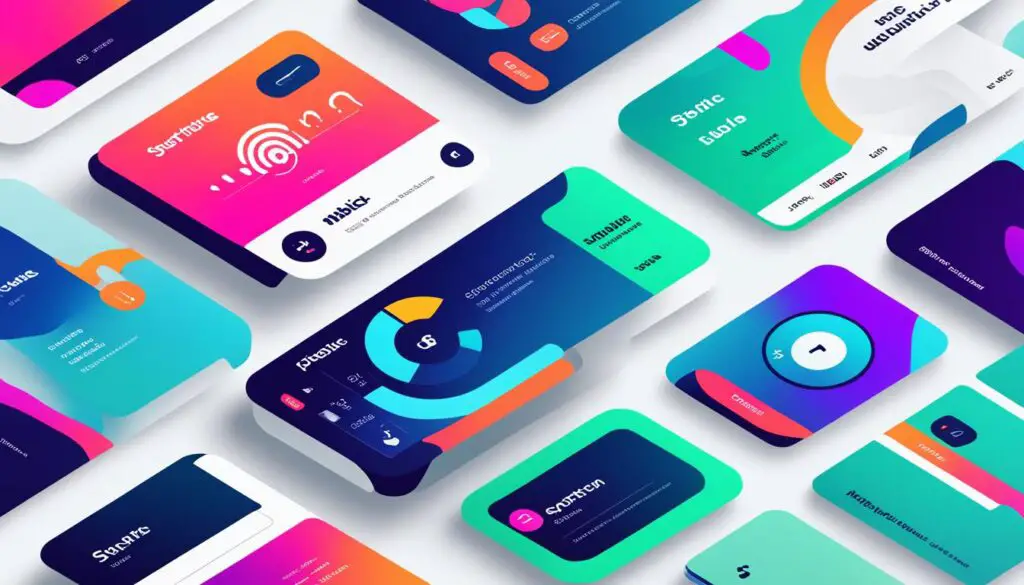The UK music scene has changed a lot due to music streaming. Before, people mainly bought CDs and vinyl. Now, they can listen to a huge range of music styles at a fixed monthly cost or for free with ads. This big switch has cut UK music sales by about 40% since 2001, now at £1.1 billion in 2021. This is a significant change for the industry.
Key Takeaways
- Music streaming has transformed the UK music industry, providing consumers with easy access to large catalogues of music for a fixed monthly price.
- Inflation-adjusted UK recorded music revenues have fallen by around 40% from 2001 to 2021, as consumers shift from owning physical formats to accessing music via streaming.
- The number of artists streaming their music has increased from around 200,000 in 2014 to 400,000 in 2020, reflecting the growing accessibility of the industry.
- The top 3 major labels hold a combined share of over 70% of UK music streams, indicating a high level of market concentration.
- The average UK artist’s yearly streaming earnings from major labels were £2,000 in 2021, with an average royalty rate of around 26%.
The Rise of Music Streaming Platforms
The music industry has changed a lot thanks to the quick growth of music streaming platforms. At first, the move to digital music led to a lot of illegal file-sharing. This made sales of CDs and other physical music drop a lot.
But, things got better with services for legal song downloads and then music streaming. These changes completely changed how people listen to and enjoy music.
Digitisation’s Impact on the Music Industry
In the beginning, digital music made illegal file-sharing more popular. This caused a big drop in money for the music industry and creators. In the UK, music money fell by 60% from 2001 to 2015 because piracy grew.
Consumers’ Embrace of Music Streaming Services
After, legal downloads and then music streaming made a real difference. Fans can now listen to music legally online. And music makers can earn from their work on the web services.
More than 80% of music gets listened to through these streaming services now. It shows how much people like them.
Shift from Ownership to Access Model
The way we listen to music changed a lot. We used to buy a few CDs or records to own. Now, we pay a monthly fee to stream unlimited music. Or we listen for free with ads.
This new way to enjoy music helps us find a lot more songs. It also helps music companies and creators make money in new ways.
Since streaming started, the money made from music in the UK has gone up. It was £0.8 billion in 2015 and reached £1.1 billion in 2021. But, it’s still not as high as before piracy was a big issue.
Market Concentration and Competition
In the UK, just three major labels – Universal, Sony, and Warner – have over 70% of music streams. This big share makes people question if it’s good for customers. So, the UK’s Competition and Markets Authority is looking into this.
Dominance of Major Record Labels
Major labels have a tight grip on the UK music streaming scene. By 2021, they controlled 70-80% of all streams. Universal was in the lead with 30-40%. Then came Sony (20-30%) and Warner (10-20%). The rest, 20-30%, went to independent labels.
Independent Labels’ Market Share
Independent labels keep about a quarter of all streams in the UK. This proportion does not change much. But, it is not easy for most indies to get a 1% share in streaming.
Competition for Artist Signings
The music world is fierce as labels fight to sign top artists. With major labels controlling most streams, they have big say in deals. This affects how money flows in the music industry.
Challenges for Creators in the Streaming Era
The music world has changed a lot with the rise of the internet. This has brought new chances and issues for artists. Many more artists now release their music thanks to easy access to recording tools and the internet.
Increase in Number of Artists Releasing Music
Since 2014, the number of artists putting out their music has doubled. It was about 200,000 then, and now it’s 400,000. New technology helps artists make and share their work. They don’t always need a big record label to do this.
Royalty Rates and Earnings for Artists
All these new artists mean more music for us to listen to. But, it also means they’re all competing for attention and money. Services like Spotify pay artists based on how many times their songs are played. So, lesser-known artists might not earn much compared to famous ones who get millions of listens.
In the UK, average royalty rates in major deals for new artists have increased steadily from 19.7% in 2012 to 23.3% in 2021. But making a living from streaming is still tough for many. This is especially true for those just starting.
And, the big record labels control most of the music we stream. They have over 70% of the UK market. This, plus the problem of music piracy, makes it hard for smaller artists to grow.

Alternative Distribution Models for Artists
Some artists pick a traditional deal with a big record label. It can bring in more money at first. Plus, these labels know how to help artists succeed. But, there are other options out there.
A&L services are one choice. They offer fewer services but more royalties for the artists. Artists can also go DIY. This means they distribute their own music without a label. They get to keep nearly all the royalties this way.
Using social media, artists can build their own fanbase. This helps in two ways. It can get more people to listen to their music online. Or, they can make money straight from their fans. This way, artists have more say in their careers and earn more money from their music.
User-Uploaded Content Platforms and Music Sharing
Technology changes have made it easier for fans, creators, and music companies to share content on sites like YouTube and TikTok. These sites are a different way for people to listen to and share music. They are changing how we discover music, making it easier to find new artists and songs.
Impact of YouTube and TikTok on Music Discovery
YouTube is a huge platform for videos, with over 2 billion people using it to listen to music. It’s great for finding new songs and artists. TikTok, on the other hand, is a place for short videos that has also become a hotspot for new music. Songs become popular through challenges and trends on this app.
These platforms are making it easy for everyone to find new music. You can come across new songs and artists just through browsing. This shift has been good for new artists. It helps them get noticed more easily, even if they’re not part of the mainstream music scene.
Yet, with these changes, the music industry is facing new challenges. It’s harder to control how music is shared and to make money from it. The industry and these platforms are often talking about how music should be shared and paid for.
Subscription Models and Consumer Trends
In recent years, the music streaming world has changed a lot. Subscription models are now very popular. People like the ease and access of on-demand music. The monthly cost of these subscriptions is very important to them.
Monthly Subscription Costs and Pricing
Prices for music streaming services have not risen with inflation. In fact, they’ve become cheaper in real terms. This makes it easier for people to access huge music catalogues through subscriptions. But, some big providers, like Spotify, are now increasing their prices. This might change how much people are willing to pay for subscriptions.
Generational Differences in Streaming Adoption
Younger people, who have always had the internet, are leading the move to subscriptions. They find it natural to listen to music through streaming services. Older folks are catching up, but their choices are more varied. Some still prefer buying or collecting physical music.
| Streaming Service | Market Share (Q3 2023) |
|---|---|
| Spotify | 31.7% |
| Apple Music | 13.7% |
| Tencent Music | 13.4% |
| Amazon Music | 13.3% |
| YouTube Music | 8.9% |
In Q3 of 2023, Spotify held the largest share of the music subscription market at 31.7%. Yet, Apple Music, Amazon Music, and YouTube Music are also gaining ground. This shows that competition and growth in the industry are ongoing.

music streaming, Spotify, Apple Music, music industry trends
Spotify’s Market Dominance
Spotify leads in the music streaming world with a 30.5% share. Then comes Apple Music at 13.7%, Tencent and Amazon at 13.3%, and YouTube Music at 8.9%. Spotify’s success comes from its big music collection, custom music picks, and easy-to-use app.
Apple Music’s Growth and Spatial Audio Strategy
Apple Music is catching up, especially with those who love high-quality sound. Its Spatial Audio offers a more immersive listening experience. Apple keeps growing in the UK by getting exclusive music and working closely with artists.
| Streaming Service | Market Share |
|---|---|
| Spotify | 30.5% |
| Apple Music | 13.7% |
| Tencent Music | 13.4% |
| Amazon | 13.3% |
| YouTube Music | 8.9% |
The latest numbers show Spotify ahead. But, Apple Music and others like Tencent and Amazon are not far behind. This means there are many choices for music lovers.
Audio Quality and Music Discovery
In today’s music world, audio quality and how well algorithms recommend music matter a lot. Big names like Spotify and Apple Music are fighting hard in this area. They both have over 100 million songs, but the way they deliver sound and suggest new music can really affect your enjoyment.
Streaming’s Impact on Audio Quality
For a long time, Spotify led the way with music streaming. It offered top-quality sound for its premium users, up to around 320kbit/s. However, Apple Music has upped its game. It now offers its vast library in lossless sound, from CD quality to high-resolution. And, it supports Dolby Atmos, making sound truly immersive for some albums.
When you compare sound quality, Apple Music often comes out on top. It sounds better than Spotify and most others. Spotify does have plans for a high-quality tier, but it’s not available yet. So, for the best sound, Apple Music leads the pack.
Music Recommendation Algorithms
Music suggestions are key too. Spotify’s Discover Weekly serves up tunes every Monday that match what you love. It’s a favourite for many. Apple Music takes a different approach. It asks you to pick your top artists and then tailors suggestions and playlists for you.
Spotify lets you create your own radio stations based on what you like. Apple Music, on the other hand, focuses on content curated by humans. This includes shows by famous musicians on Apple Music 1.
Legal and Licensing Considerations
The music industry’s move to digital has made the legal and licensing scene more complicated. With music streaming on the rise, issues like copyright breaching, how licenses work, and sharing royalties fairly have come to light.
Royalty Distribution and Licensing Agreements
Deals between big record labels and streaming services are complex. They’re often arguing over what’s fair pay for musicians and those owning the rights. Getting the right permits for streaming music is key to staying out of legal trouble. But, unfair sharing of profits has caused never-ending debates on who gets what.
Transparency in Streaming Royalties
Many argue that streaming payments should be more open. Even with new tech, questions linger about how money is split up, especially for indie artists and small rights owners. Laws are being made to fix these issues and modernize copyright law for the digital age. The goal is a clearer, fairer system that benefits everyone.
FAQ
How has music streaming transformed the music industry?
How did digitisation impact the music industry?
What is the current market concentration in the recorded music sector?
How has the number of artists releasing music changed?
What are the alternatives to traditional record deals for artists?
How have user-uploaded content platforms impacted music sharing?
How have subscription prices for music streaming services changed over time?
What is the current market share of leading music streaming services?
How has streaming impacted the lifecycle of song earnings?
How is the competition between music streaming services working for consumers?
Source Links
- https://www.gov.uk/government/publications/music-and-streaming-market-study-update-paper/executive-summary
- https://explodingtopics.com/blog/music-streaming-stats
- https://www.businessofapps.com/data/music-streaming-market/
- https://www.apple.com/uk/newsroom/2024/03/the-app-store-spotify-and-europes-thriving-digital-music-market/
- https://www.linkedin.com/pulse/key-harmonies-music-streaming-market-analysis-trends-maria-howard-hnhic
- https://labelgrid.com/blog/content-distribution/challenges-faced-by-modern-record-labels-navigating-the-digital-age/
- https://assets.publishing.service.gov.uk/media/6384edb7e90e07789ae1271c/Music_and_streaming_final_report_executive_summary.pdf
- https://www.bbvaopenmind.com/en/articles/the-music-industry-in-an-age-of-digital-distribution/
- https://www.goldmansachs.com/intelligence/page/music-streaming-services-are-on-the-cusp-of-major-structural-change.html
- https://www.midiaresearch.com/blog/global-music-subscription-market-sees-growth-led-by-emerging-markets-midia-research-q3-2023-report
- https://fastercapital.com/content/Music-subscription-model–Exploring-the-Impact-of-Music-Subscription-Models-on-Consumer-Behavior.html
- https://imusician.pro/en/resources/blog/state-of-the-music-industry-2024-on-growth-challenges-and-the-need-for-tangible-solutions
- https://musicalpursuits.com/music-streaming/
- https://medium.com/@iamtimbaker/spotify-vs-apple-music-which-is-better-7b1aecb23039
- https://www.digitaltrends.com/mobile/apple-music-vs-spotify/
- https://www.usemogul.com/post/are-there-any-legal-issues-surrounding-digital-music-sales
- https://journals.library.columbia.edu/index.php/lawandarts/article/view/8953



